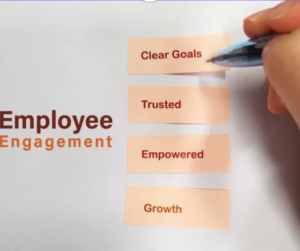
We explored how ways of thinking (Mindsets) influence actions (Behaviors); now it’s time to delve into the third and last part of the equation — Outcomes. The delicate dance between individual and organizational outcomes in the workplace has captivated management professionals and employees alike for decades. Striking the right balance between personal aspirations and organizational goals is not merely a philosophical pursuit, but a crucial step in building a thriving ecosystem where both entities can flourish.
Understanding Individual Outcomes:
At the core of individual well-being lie fundamental dimensions that shape employees’ experience within the organization. These include:
- Job Performance and Goal Attainment: When employees feel equipped and valued, their performance thrives. Providing opportunities for skill development, setting clear expectations, and offering growth opportunities are crucial. Goal-setting, coupled with consistent feedback and recognition, further empowers individuals to achieve their full potential.
- Job Satisfaction and Engagement: Beyond performance, fostering job satisfaction and engagement unlocks an additional layer of motivation and commitment. This can be achieved by creating a positive work environmentbuilt on trust, respect, and open communication. Offering meaningful work, where individuals feel their contributions matter, further fosters a sense of purpose and engagement.
- Resilience and Stress Management: The workplace is not immune to stressors. Equipping employees with the tools to manage these stressors effectively is paramount. Encouraging open communication, promoting healthy work-life balance, and providing access to wellness resources like mindfulness training or employee assistance programs can significantly contribute to building individual resilience.

Organizational Outcomes: A Different Side of the Coin:
From an organizational perspective, fostering individual well-being is not merely altruistic; it translates into tangible benefits:
- Turnover Reduction: High employee turnover disrupts operations and incurs costs. By investing in individual well-being, fostering a positive environment, and offering career development opportunities, organizations can retain valuable talent, reducing the associated costs and disruptions.
- Increased Productivity and Efficiency: When employees are satisfied and engaged, their productivity and efficiency naturally rise. This translates to improved operational outcomes, leading to a stronger bottom line for the organization.
- Innovation and Creativity: A diverse and engaged workforce is a breeding ground for innovative solutions. By empowering employees to take ownership, share ideas freely, and fostering a culture of psychological safety, organizations can unlock the collective creative potential of their workforce.
- Positive Reputation and Employer Branding: A company recognized for prioritizing employee well-being attracts and retains top talent. This strengthens the organization’s employer brand, making it a more attractive prospect in an increasingly competitive talent market.
The Synergy of Outcomes: A Virtuous Cycle:
The true magic lies in the synergy between these seemingly distinct sets of outcomes. By investing in individual well-being and fostering a positive work environment, organizations witness a positive ripple effect. Employee satisfaction translates to increased engagement and productivity, leading to improved organizational outcomes. This, in turn, allows organizations to further invest in employee well-being, creating a virtuous cycle of mutual benefit and long-term success.

Moving Beyond the Individual and the Organization: A Holistic Approach:
It’s crucial to acknowledge that the workplace ecosystem extends beyond just individuals and organizations. Factors like industry trends, technological advancements, and even socioeconomic conditions can play a significant role in shaping both individual and organizational outcomes. This necessitates a holistic approach that considers the broader context when designing strategies and interventions aimed at fostering a thriving work environment.
Conclusion:
Ultimately, understanding and nurturing both individual and organizational outcomes isn’t just about achieving optimal performance, but about creating a sustainable work ecosystem where both sides can thrive. By fostering a culture of mutual respect, growth, and well-being, organizations can unlock a potent force that drives innovation, success, and a truly fulfilling workplace experience for all.